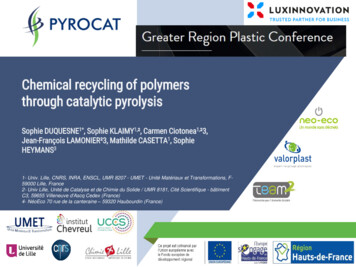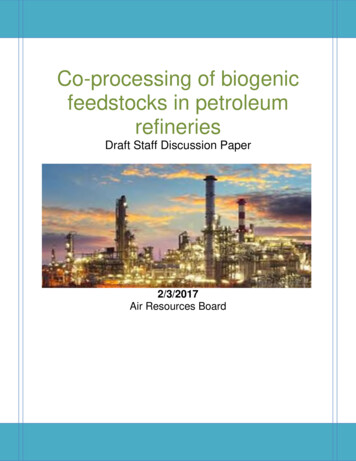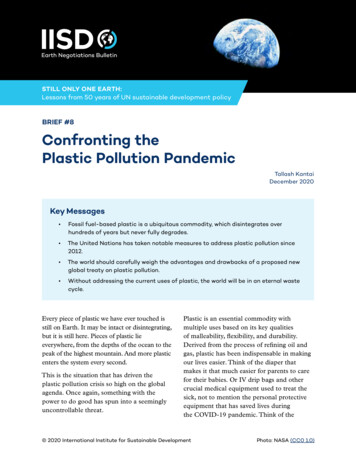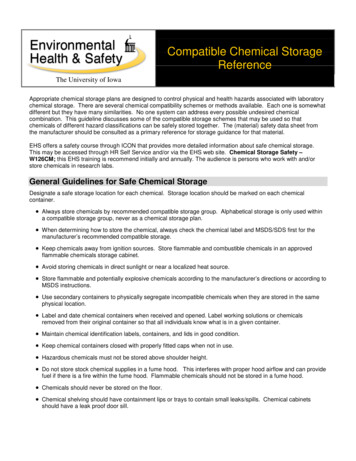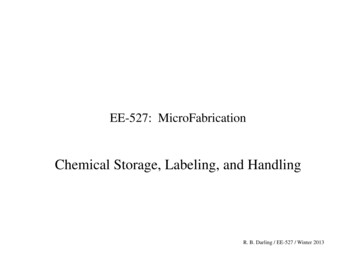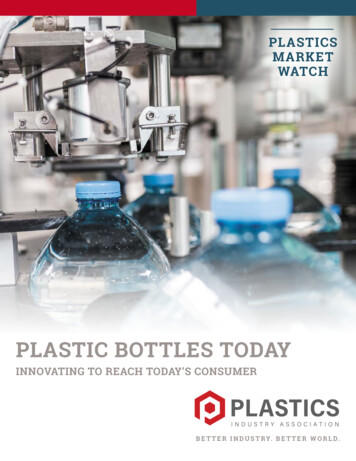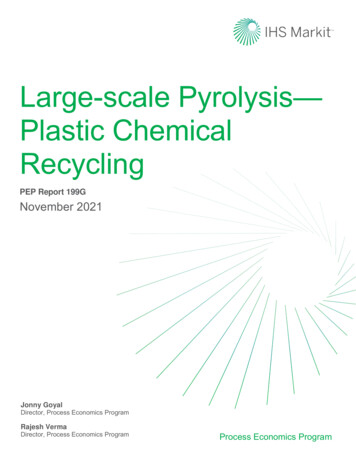
Transcription
Large-scale Pyrolysis—Plastic ChemicalRecyclingPEP Report 199GNovember 2021Jonny GoyalDirector, Process Economics ProgramRajesh VermaDirector, Process Economics ProgramProcess Economics Program
IHS Markit PEP Report 199G Large-scale Pyrolysis—Plastic Chemical RecyclingContactsJonny GoyalDirector, Process Economics Programjonny.goyal@ihsmarkit.comRajesh VermaDirector, Process Economics Programrajesh.verma@ihsmarkt.comMichael ArnéVice President, Process Economics Programmichael.arne@ihsmarkit.comConfidential. 2021 IHS Markit. All rights reserved.1November 2021
IHS Markit PEP Report 199G Large-scale Pyrolysis—Plastic Chemical RecyclingPEP Report 199GLarge-scale Pyrolysis—Plastic Chemical RecyclingJonny Goyal, Director, Process Economics ProgramRajesh Verma, Director, Process Economics ProgramAbstractPlastic has become one of the most ubiquitous materials in our lifestyle. However, the proliferation ofplastics that contaminate rivers, oceans, and landfills has also brought adverse environmentalconsequences. This is a major global challenge and has sparked a strong interest in the more efficientproduction, use, and disposal of plastics, in line with the principles of the circular economy. There isalso increasing regulatory pressure regarding recycling quota and recyclability along with strongcommitments from global chemical industries toward increasing the share of recycled material in theirofferings. As the chemical makers are under pressure to solve the plastic waste problem, firms areincreasingly exploring chemical recycling as a complement to traditional mechanical techniques,which reform the plastic into a usable pellet only. However, the capacity of plastic chemical recyclingvia pyrolysis is limited because the technology solution is at only 10–50 tpd of plant capacity. Largescale pyrolysis is being investigated as an option so that a large volume of plastic waste can be handled.This report is focused on chemical recycling of plastics, mainly polyolefins from mixed waste plastics,using large-scale pyrolysis in plants with capacity ranging from 300 to 2,000 tpd. The objective of thisreport is to evaluate the process economics of such large-sized plants. IHS Markit presents acomprehensive description of the technology aspects, shows the current worldwide industry status, anddiscusses the major risk factors related to technology implementation. We also explore the factors thatwill eventually decide the large scale and various options for upgrading pyrolysis oil for different scalesof pyrolysis plants. The following cases are covered in this report: Case I: Brightmark’s 317 tpd of plastic pyrolysis plant in Ashley, Indiana, United States Case II: A 1,000 tpd large-scale pyrolysis under various scenarios Case III: A 2,000 tpd large-scale pyrolysis under various scenarios, including the use of differentspecific feedstocks and associated yieldsWe have used the IHS Markit internal tools to work out a process design and its economics. We haveaddressed the issue of pyrolysis oil quality by implementing downstream hydrotreating and dewaxingunits, as applicable, to develop capital investment estimates for the various process cases. The mainchallenges associated with the economics of large-scale plastic pyrolysis processes are ensuringfeedstock quality, supply and price over the long term, choice of products and by-products, reactor sizeand catalyst, and tipping fee. Targeting high-market price products provides benefits where theeconomics can be met at medium-to-high-range pyrolysis plants with a tpd greater than 1,000.Feedstock quality plays a critical role and high feedstock price may need to be considered. On the otherhand, large-scale pyrolysis plants with a 2,000 tpd capacity can potentially be economically viable,depending upon the conditions of the product market prices. It is difficult to predict if the industry willbe going directly toward the implementation of a 2,000 tpd plant for chemical recycling because thetechnology is not yet mature. Most of the current pyrolysis players now use a modular approach of 10–Confidential. 2021 IHS Markit. All rights reserved.2November 2021
IHS Markit PEP Report 199G Large-scale Pyrolysis—Plastic Chemical Recycling50 tpd. To bring it to an industrial scale, chemical recycling needs to strike a balance between economicviability, regulatory compliance, and environmental impact.Confidential. 2021 IHS Markit. All rights reserved.3November 2021
IHS Markit PEP Report 199G Large-scale Pyrolysis—Plastic Chemical RecyclingContents12345IntroductionSummaryThree cases for comparisonBrightmark’s plastic pyrolysis process in Ashley, IndianaBrightmark’s 1,000 tpd plastic pyrolysis conceptual design—Scale upA 2,000 tpd single-train mixed waste plastic pyrolysis plantEconomic aspectsCapital cost economics comparisonProduct cost economics comparisonCarbon emissions summaryConclusionsSome other important pointsIndustry statusPlastic-to-oil companies, technology type, and statusNew Hope Energy/ Lummus TechnologyBrightmark (RES Polyflow)Mura-KBR/Licella’s Cat-HTR (hydrothermal treatment process)EncinaLyondellBasellPlastic Energy /CynarAgilyxRecycling TechnologiesRenewlogy (formerly PK Clean)Alterra Energy (formerly Vadxx Energy)Total/Synova/Technip EnergiesNexus Fuels, LLCLarge-scale plastic pyrolysis technology reviewThe issues with crude pyrolysis oilUpgrading pyrolysis oilUpgrading using catalytic crackingUpgrading using simple distillation or blending purposeUpgrading by hydrotreating and/or hydrocracking/hydroprocessingDewaxingOther fuel finishing operationsFuel additivesCommercial references for pyrolysis oil upgrading unitsUpgradation of pyrolysis oil for different scale pyrolysisMain factors defining the large-scale capacity for a plantPopulation density and the location of the plantLimitation on the upstream material recycling facility and its capacityReactor size limitations (technology licensor’s perspective)Deciding the end product beforehand (only as blending fuel, combined heat power fuel, or asmonomer)Business model/possible solution/or the way forwardOther factors and comparisonsSense of urgency and government regulationsCase I: Brightmark (RES Polyflow) pyrolysis process# DisclaimerIntroductionCase assumptionsProcess descriptionSection 100—Feed preparationSection 200—Plastic conversion and vapor condensationSection 300—Hydrotreating, fractionator, and fuel gas cleaningConfidential. 2021 IHS Markit. All rights 6868686871727273November 2021
IHS Markit PEP Report 199G Large-scale Pyrolysis—Plastic Chemical RecyclingSection 400—Dewaxing section74Process discussion88Brightmark process configuration and type89Description of reactor and equipment assembly91Plant capacity, feedstock composition, and flow rate93Brightmark process yield93Process fuel gas and solid char94Product quality of Brightmark ade wax quality from the Brightmark process/dewaxing unit96Materials of construction98Emissions98Cost estimates99Fixed capital costs100Production costs104Sensitivity analysis and cost discussion107Conclusions1106Case II: Brightmark 1,000 tpd plastic pyrolysis conceptual design—Scale up111Case introduction111Sensitivity analysis and cost discussion—Single-train 1,000 tpd Brightmark113Sensitivity analysis and cost discussion—Two trains, 500 tpd each (Brightmark)118Conclusions1217Case III: IHS Markit conceptual design for a large-scale (2,000 tpd) waste plastic pyrolysisplant for liquid fuel production122Introduction122Process design basis122Storage facility124Material of construction125Process description125Pyrolysis feed preparation section (Section 100)126Pyrolysis reaction section (Section 200)126Pyro product hydrotreatment section (Section 300)127Pyro product fractionation section (Section 400)128Process discussion142Feedstock composition142Plant capacity and location143Feed pretreatment facility143Size reduction and sorting143Dehydrochlorination144Pyrolysis section145Pyrolysis reactor145Fluidizing medium146Pyrolysis operating conditions147Heating rate147Temperature147Particle size148Residence time148Pressure148Catalyst149Pyro oil quality150Pyro oil hydrotreatment151Operating conditions151Catalyst151Product fractionation152Emission and wastes152Cost estimates152Fixed capital costs153Production costs153Confidential. 2021 IHS Markit. All rights reserved.3November 2021
IHS Markit PEP Report 199G Large-scale Pyrolysis—Plastic Chemical Recycling8Sensitivity analysis161Process economics for two trains, with 1,000 tpd capacity each, operating in parallel (Diesel Case1)161Process economics for eight trains, with 250 tpd capacity each, operating in parallel with commonproduct purification and recovery sections (Diesel Case-2)162Process economics for eight trains, with 250 tpd capacity each, operating in parallel with separateproduct purification and recovery sections (Diesel Case-3)163Process economics for hydrotreated pyro oil (Base case)164Process economics for hydrotreated pyro oil (Case-4)165Process economics for hydrotreated pyro oil (Case-5)166Process economics for hydrotreated pyro oil (Case-6)167Process economics for hydrotreated pyro oil (Case-7)168Process economics for hydrotreated pyro oil (Case-8)169Process economics for hydrotreated pyro oil (Case-9)170Process economics for hydrotreated pyro oil (Case-10)171Appendix A—Cited references177Appendix B—Patents185Appendix C—Process flow diagrams187TablesTable 2.1 Drivers for feasibility of plastic chemical recycling processes12Table 2.2 Overall comparison of different large-scale plastic pyrolysis process cases evaluated14Table 2.3 Overall comparison of capital investment and product cost15Table 3.1 Companies that recycle plastics via thermal way23Table 4.1 Typical operating parameters and products for pyrolysis process37Table 4.2 Typical heat requirements for pyrolysis of different plastics38Table 4.3 Main resin types in recycled plastic waste streams and their pyrolysis products38Table 4.4 Typical comparison of pyrolysis oil from different feedstocks versus conventional diesel oil 39Table 4.5 Typical elemental analysis of different plastic waste40Table 4.6 Typical elemental analysis of pyrolysis oil produced from different plastics41Table 4.7 Summary of studies on different pyrolysis using different reactors and operating conditions 42Table 4.8 Overview of different pyrolysis reactor types, their typical comparison for use for the pyrolysisprocess43Table 4.9 A typical gas composition after pyrolysis of different plastics44Table 4.10 Different plastic types listed by heteroatoms45Table 4.11 An estimation of the levels of contaminants present in crude oil and postconsumer plastics 45Table 4.12 Purification and upgrading of pyrolysis liquid oils46Table 4.13 Typical pyrolysis oil composition from the pyrolysis of different plastics47Table 4.14 Properties of conventional crude oils48Table 4.15 Typical crude oil assays for the different specifications and comparison49Table 4.16 Effect of catalytic cracking on the quality of different plastic pyrolysis oils50Table 4.17 Conventional hydrotreating and hydrocracking ranges of H 2 partial pressure and conversion54Table 4.18 Typical operating parameters used for hydroprocessing of plastic pyrolysis oil54Table 4.19 Different properties of MEK and toluene as a solvent for dewaxing process57Table 4.20 Impact of dewaxing solvent composition on dewaxing process operating conditions58Table 4.21 Some of the licensors for upgrading pyrolysis oil from plastics60Table 5.1 Brightmark pyrolysis process for plastic recycling (Case I)—Basis of design70Table 5.2 Unit material balance and key performance parameters75Table 5.3 Brightmark plastic pyrolysis process (317.5 tpd of waste plastic input) for Case-1—Materialstream flows (in lbs/hr)76Table 5.4 Brightmark plastic pyrolysis process (317.5tpd of waste plastic input) for Case-1—Majorequipment84Table 5.5 Brightmark plastic pyrolysis process (317.5 tpd of waste plastic input) for Case-1—UtilitysummaryTable 5.6 Reference of commercial vessel volume from US 20170283706A1 (Table 5)92Table 5.7 Feed mixture composition, wt% (as adopted from Table 1 in US 20170283706A1)93Table 5.8 Pyrolysis oil from Brightmark process—ASTM distillation data from US 20170283706A1 (Table5)95Confidential. 2021 IHS Markit. All rights reserved.4November 2021
IHS Markit PEP Report 199G Large-scale Pyrolysis—Plastic Chemical RecyclingTable 5.9 Fully refined paraffin wax 52/54 properties (as obtained from vendor website)97Table 5.10 Brightmark pyrolysis process—Net CO2 emission99Table 5.11 Brightmark plastic pyrolysis process (317.5 tpd of waste plastic input)—Case-1101Total capital investment101Table 5.12 Brightmark plastic pyrolysis process (317.5 tpd of waste plastic input)—Case 1102Total capital investment by section102Table 5.13 Brightmark plastic pyrolysis process (317.5 tpd of waste plastic input)—Case 1105Production cost105Table 5.14 Sensitivity analysis—Impact of wax price on net production cost and product value107Table 5.15 Sensitivity analysis—Impact of feedstock price on net production cost and product value 109Table 6.1 Brightmark 1,000 tpd plastic pyrolysis conceptual design—Single train (Scenario 1)113Table 6.2 Sensitivity analysis—Impact of wax price on net production cost and product value114Table 6.3 Sensitivity analysis—Impact of feedstock price on net production cost and product value 115Table 6.4 Brightmark 1,000 tpd plastic pyrolysis conceptual design—Two trains 500 tpd each (Scenario2)118Table 6.5 Sensitivity analysis—Impact of wax price on net production cost and product value119Table 6.6 Sensitivity analysis—Impact of feedstock price on net production cost and product value 120Table 7.1 IHS Markit conceptual design for large-scale waste plastic pyrolysis to liquid fuel—Design basesand assumptions123Table 7.2 Unit material balance and key performance parameters129Table 7.3 IHS Markit conceptual design for a large-scale waste plastic pyrolysis plant for liquid fuelproduction—Major streams flow130Table 7.4 IHS Markit conceptual design for a large-scale waste plastic pyrolysis plant for liquid fuelproduction—Major equipment138Table 7.5 IHS Markit conceptual design for a large-scale waste plastic pyrolysis plant for liquid fuelproduction——Utility summary142Table 7.6 Waste plastic feedstock composition143Table 7.7 Some industrial facilities for plastic pyrolysis (thermal and catalytic process)150Table 7.8 IHS Markit conceptual design for a large-scale waste plastic pyrolysis plant for liquid fuelproduction—Total capital investment154Table 7.9 IHS Markit conceptual design for large-scale waste plastic pyrolysis to liquid fuel—Capitalinvestment by sectionError! Bookmark not defined.Table 7.10 IHS Markit conceptual design for a large-scale waste plastic pyrolysis plant for liquid fuelproduction—Variable costs157Table 7.11 IHS Markit conceptual design for a large-scale waste plastic pyrolysis plant for liquid fuelproduction—Production costs158Table 8.1 Large-scale waste plastic pyrolysis plant for liquid fuel production with two trains operating inparallel—Production costs162Table 8.2 Large-scale waste plastic pyrolysis plant for liquid fuel production with eight trains operating inparallel with common product purification and recovery section—Production costs163Table 8.3 Large-scale waste plastic pyrolysis plant for liquid fuel production with eight trains operating inparallel with separate product purification and recovery sections—Production costs164Table 8.4 Large-scale waste plastic pyrolysis plant for hydrotreated Pyro Oil production (Base case—Production costs165Table 8.5 Large-scale waste plastic pyrolysis plant for hydrotreated pyro oil production (Case-1)—Production costs166Table 8.6 Large-scale waste plastic pyrolysis plant for hydrotreated pyro oil production (Case-2)—Production costs167Table 8.7 Large-scale waste plastic pyrolysis plant for hydrotreated pyro oil production (Case-3)—Production costs168Table 8.8 Large-scale waste plastic pyrolysis plant for hydrotreated pyro oil production (Case-4)—Production costs169Table 8.9 Large-scale waste plastic pyrolysis plant for hydrotreated pyro oil production (Case-5)—Production costs170Table 8.10 Large-scale waste plastic pyrolysis plant for hydrotreated pyro oil production (Case-6)—Production costs171Table 8.11 Large-scale waste plastic pyrolysis plant for hydrotreated pyro oil production (Case-7)—Production costs172Confidential. 2021 IHS Markit. All rights reserved.5November 2021
IHS Markit PEP Report 199G Large-scale Pyrolysis—Plastic Chemical RecyclingFiguresFigure 2.1 Capital cost comparison16Figure 2.2 Production cost comparison17Figure 3.1 KIT fast pyrolysis process scheme32Figure 3.2 Typical representation of Plastic Energy/Cynar Plastic recycling process33Figure 3.3 Agilyx technology supplied to GenAgain—Process flow diagram34Figure 3.4 Process flow scheme—Nexus Fuel plastic pyrolysis process36Figure 4.1 Typical scheme of single-stage hydrotreater54Figure 4.2 Typical scheme of single-stage hydrotreater55Figure 4.3 Simplified flow diagram of a dewaxing plant57Figure 4.4 Pyrolysis oil upgrading (Option 1)61Figure 4.5 Pyrolysis oil upgrading (Option 2)62Figure 4.6 Pyrolysis oil upgrading (Option 3)62Figure 4.7 Positioning MRF for plastic chemical recycling of large-scale plants64Figure 5.1 Basic set-up of trains for Brightmark’s plastic pyrolysis process90Figure 5.2 A typical arrangement of Brightmark’s pyrolysis process equipment configuration91Figure 5.3 Brightmark (RES Polyflow) pyrolyzer reactor system arrangement (US 20170283706A1) 92Figure 5.4 Brightmark plastic pyrolysis process (317.5 tpd of waste plastic input)—Case 1104Effect of plant capacity on investment cost104Figure 5.5 Brightmark plastic pyrolysis process (317.5 tpd of waste plastic input)—Case 1107Effect of plant operating level on net production cost107Figure 5.6 Sensitivity analysis—Impact of wax price on net production cost and product value108Figure 5.7 Sensitivity analysis—Impact of feedstock price on net production cost and product value 109Figure 6.1 Preliminary scheme for a 1,000 tpd plastic pyrolysis with single train (Scenario 1)112Figure 6.2 Sensitivity analysis—Impact of wax price on net production cost and product value114Figure 6.3 Sensitivity analysis—Impact of feedstock price on net production cost and product value 116Figure 6.4 Preliminary scheme for 1,000 tpd plastic pyrolysis with two trains (scenario 2)117Figure 6.5 Sensitivity analysis—Impact of wax price on net production cost and product value119Figure 6.6 Sensitivity analysis—Impact of feedstock price on net production cost and product value 121Figure 7.1 Effect of plant capacity on investment costs159Figure 7.2 Effect of waste plastic feed price on net production cost and product value159Figure 7.3 Effect of light oil by-product price on net production cost and product value160Figure 7.4 Effect of plant operating level on net production cost160Figure 8.1 Capital cost comparison for diesel production172Figure 8.2 Comparison of production costs for diesel production173Figure 8.3 Capital cost comparison for pyro oil production174Figure 8.4 Production costs comparison for pyro oil production175Figure 8.5 Effect of paraffin wax by-product price on pyro oil net production cost and product value (Case5)176Appendix C FiguresFigure 9.1 PFD 1 of 4: Brightmark plastic pyrolysis process (Case I)Figure 9.1 PFD 2 of 4: Brightmark plastic pyrolysis process (Case I)Figure 9.1 PFD 3 of 4: Brightmark plastic pyrolysis process (Case I)Figure 9.1 PFD 4 of 4: Brightmark plastic pyrolysis process (Case I)Figure 9.2 PFD 1 of 4: IHS Markit conceptual design for a large-scaleliquid fuel productionFigure 9.2 PFD 2 of 4: IHS Markit conceptual design for a large-scaleliquid fuel productionFigure 9.2 PFD 3 of 4: IHS Markit conceptual design for a large-scaleliquid fuel productionFigure 9.2 PFD 4 of 4: IHS Markit conceptual design for a large-scaleliquid fuel productionConfidential. 2021 IHS Markit. All rights reserved.6waste plastic pyrolysiswaste plastic pyrolysiswaste plastic pyrolysiswaste plastic pyrolysis188189190191plant for192plant for193plant for194plant for195November 2021
IHS Markit Customer Care:CustomerCare@ihsmarkit.comAsia and the Pacific RimJapan: 813 6262 1887Asia Pacific: 604 291 3600Europe, Middle East, and Africa: 44 1344 328 300Americas: 1 800 447 2273DisclaimerThe information contained in this presentation is confidential. Any unauthorized use, disclosure, reproduction, or dissemination, in full or inpart, in any media or by any means, without the prior written permission of IHS Markit or any of its affiliates ("IHS Markit") is strictlyprohibited. IHS Markit owns all IHS Markit logos and trade names contained in this presentation that are subject to license. Opinions,statements, estimates, and projections in this presentation (including other media) are solely those of the individual author(s) at the time ofwriting and do not necessarily reflect the opinions of IHS Markit. Neither IHS Markit nor the author(s) has any obligation to update thispresentation in the event that any content, opinion, statement, estimate, or projection (collectively, "information") changes or subsequentlybecomes inaccurate. IHS Markit makes no warranty, expressed or implied, as to the accuracy, completeness, or timeliness of anyinformation in this presentation, and shall not in any way be liable to any recipient for any inaccuracies or omissions. Without limiting theforegoing, IHS Markit shall have no liability whatsoever to any recipient, whether in contract, in tort (including negligence), under warranty,under statute or otherwise, in respect of any loss or damage suffered by any recipient as a result of or in connection with any informationprovided, or any course of action determined, by it or any third party, whether or not based on any information provided. The inclusion of alink to an external website by IHS Markit should not be understood to be an endorsement of that website or the site's owners (or theirproducts/services). IHS Markit is not responsible for either the content or output of external websites. Copyright 2021, IHS Markit . Allrights reserved and all intellectual property rights are retained by IHS Markit.
Large-scale Pyrolysis— Plastic Chemical Recycling PEP Report 199G November 2021 Process Economics Program Jonny Goyal Director, Process Economics Program
